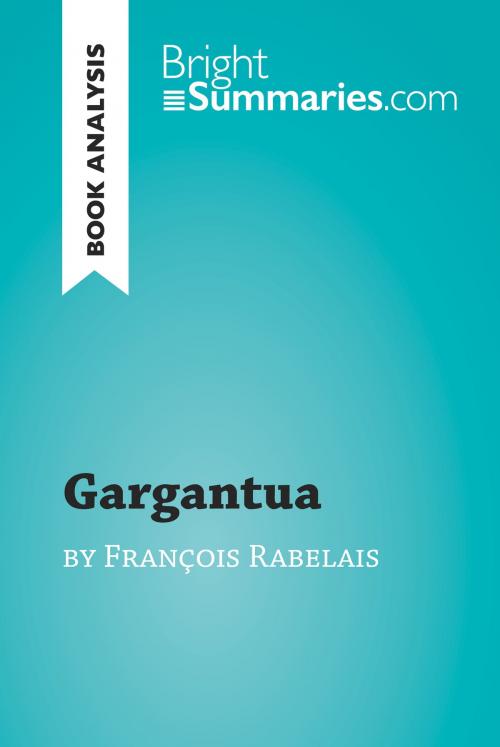Gargantua by François Rabelais (Book Analysis)
Detailed Summary, Analysis and Reading Guide
Nonfiction, Reference & Language, Study Aids, Book Notes, Fiction & Literature, Anthologies| Author: | Bright Summaries | ISBN: | 9782806296542 |
| Publisher: | BrightSummaries.com | Publication: | May 24, 2017 |
| Imprint: | BrightSummaries.com | Language: | English |
| Author: | Bright Summaries |
| ISBN: | 9782806296542 |
| Publisher: | BrightSummaries.com |
| Publication: | May 24, 2017 |
| Imprint: | BrightSummaries.com |
| Language: | English |
Unlock the more straightforward side of Gargantua with this concise and insightful summary and analysis!
This engaging summary presents an analysis of Gargantua by François Rabelais, the follow-up to the popular novel Pantagruel. In this satirical tale, Rabelais tells the story of Gargantua, the father of the giant we meet in the first book, and describes the trials and tests he faces along his path to education. Gargantua was published in 1534 but met with considerable controversy, as a result of its bawdy language and numerous possible interpretations. Rabelais himself was no stranger to public outrage, being widely known as a drunkard with a talent for stirring up strong reactions. He is best-known for his pentalogy of novels about the adventures of two giants, Pantagruel and Gargantua, and is considered to be one of the most significant writers in Western literature.
Find out everything you need to know about Gargantua in a fraction of the time!
This in-depth and informative reading guide brings you:
• A complete plot summary
• Character studies
• Key themes and symbols
• Questions for further reflection
Why choose BrightSummaries.com?
Available in print and digital format, our publications are designed to accompany you on your reading journey. The clear and concise style makes for easy understanding, providing the perfect opportunity to improve your literary knowledge in no time.
See the very best of literature in a whole new light with BrightSummaries.com!
This engaging summary presents an analysis of Gargantua by François Rabelais, the follow-up to the popular novel Pantagruel. In this satirical tale, Rabelais tells the story of Gargantua, the father of the giant we meet in the first book, and describes the trials and tests he faces along his path to education. Gargantua was published in 1534 but met with considerable controversy, as a result of its bawdy language and numerous possible interpretations. Rabelais himself was no stranger to public outrage, being widely known as a drunkard with a talent for stirring up strong reactions. He is best-known for his pentalogy of novels about the adventures of two giants, Pantagruel and Gargantua, and is considered to be one of the most significant writers in Western literature.
Find out everything you need to know about Gargantua in a fraction of the time!
This in-depth and informative reading guide brings you:
• A complete plot summary
• Character studies
• Key themes and symbols
• Questions for further reflection
Why choose BrightSummaries.com?
Available in print and digital format, our publications are designed to accompany you on your reading journey. The clear and concise style makes for easy understanding, providing the perfect opportunity to improve your literary knowledge in no time.
See the very best of literature in a whole new light with BrightSummaries.com!
Unlock the more straightforward side of Gargantua with this concise and insightful summary and analysis!
This engaging summary presents an analysis of Gargantua by François Rabelais, the follow-up to the popular novel Pantagruel. In this satirical tale, Rabelais tells the story of Gargantua, the father of the giant we meet in the first book, and describes the trials and tests he faces along his path to education. Gargantua was published in 1534 but met with considerable controversy, as a result of its bawdy language and numerous possible interpretations. Rabelais himself was no stranger to public outrage, being widely known as a drunkard with a talent for stirring up strong reactions. He is best-known for his pentalogy of novels about the adventures of two giants, Pantagruel and Gargantua, and is considered to be one of the most significant writers in Western literature.
Find out everything you need to know about Gargantua in a fraction of the time!
This in-depth and informative reading guide brings you:
• A complete plot summary
• Character studies
• Key themes and symbols
• Questions for further reflection
Why choose BrightSummaries.com?
Available in print and digital format, our publications are designed to accompany you on your reading journey. The clear and concise style makes for easy understanding, providing the perfect opportunity to improve your literary knowledge in no time.
See the very best of literature in a whole new light with BrightSummaries.com!
This engaging summary presents an analysis of Gargantua by François Rabelais, the follow-up to the popular novel Pantagruel. In this satirical tale, Rabelais tells the story of Gargantua, the father of the giant we meet in the first book, and describes the trials and tests he faces along his path to education. Gargantua was published in 1534 but met with considerable controversy, as a result of its bawdy language and numerous possible interpretations. Rabelais himself was no stranger to public outrage, being widely known as a drunkard with a talent for stirring up strong reactions. He is best-known for his pentalogy of novels about the adventures of two giants, Pantagruel and Gargantua, and is considered to be one of the most significant writers in Western literature.
Find out everything you need to know about Gargantua in a fraction of the time!
This in-depth and informative reading guide brings you:
• A complete plot summary
• Character studies
• Key themes and symbols
• Questions for further reflection
Why choose BrightSummaries.com?
Available in print and digital format, our publications are designed to accompany you on your reading journey. The clear and concise style makes for easy understanding, providing the perfect opportunity to improve your literary knowledge in no time.
See the very best of literature in a whole new light with BrightSummaries.com!















